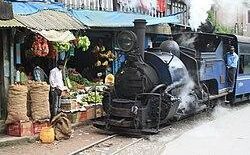#5 Narrow Gauge Wonders: The Darjeeling Himalayan Railway & Nilgiri Mountain Railway (Indian Railways Series)
0 India is home to some incredible feats of railway engineering that tamed the mighty Himalayas and the rolling Nilgiri hills. Winding their way up into the clouds, the Darjeeling Himalayan Railway and Nilgiri Mountain Railway are narrow gauge wonders that tame the mighty mountains of India. These century old marvels of engineering continue to transport travelers back in time on an incredible journey into the hills. Join this blog on a journey to discover two of these narrow-gauge wonders. The Darjeeling Himalayan Railway Do you know that the Darjeeling Himalayan Railway is more than a century old and still chugging along? In the late 19th century, the British decided to connect Darjeeling with the plains to boost tourism and the tea trade. But laying tracks over steep Himalayan terrain was extremely challenging. You will be amazed to know that the route rises from just 100 feet at New Jalpaiguri to over 7,000 feet at Darjeeling. The only solution was to build a narrow gauge railway with tight 10-foot curves, specially designed steam locomotives, and ingenious zig-zag loops. Work started in 1879 and was completed by 1881. This engineering marvel soon came to be known as the Toy Train. It passes through beautiful landscapes – dense forests, tea plantations, and precarious mountain slopes. An incredible journey of just 50 miles takes almost 9 hours to complete. The Nilgiri Mountain Railway Further south in Tamil Nadu lies another masterpiece – the Nilgiri Mountain Railway. Built by the British in 1908, it connects the Queen of Hills, Ooty, with the plains. You will be shocked to know that the 46 km journey takes over 5 hours to ascend 4,000 feet! The steam locomotives have special piston valves to work on the steep gradient. The tracks pass over 250 bridges, some made from raw tree trunks. The train goes through 16 tunnels carved out of the hills. The most amazing section is the loop between Kallar and Coonoor, where the track spirals back above itself. UNESCO Heritage Sites In 1999, UNESCO declared both the Darjeeling and Nilgiri Mountain Railways as World Heritage Sites. They represent the unified efforts of both British engineers and Indian laborers, who overcame immense challenges to build these lines. These narrow gauge hill trains provide a window into a bygone era of rail travel. Many sections still use the original steam locomotives. So prepare to huff and puff up towards the clouds on these wonders from another century. Riding up on the Toy Train or Nilgiri Mountain Railway is a memorable experience that every rail fan must have at least once. These engineering marvels continue to conquer the mountains against all odds, even today. They are truly gems of India’s railway heritage. Sources- The Darjeeling Himalayan Railway For the historical background:






